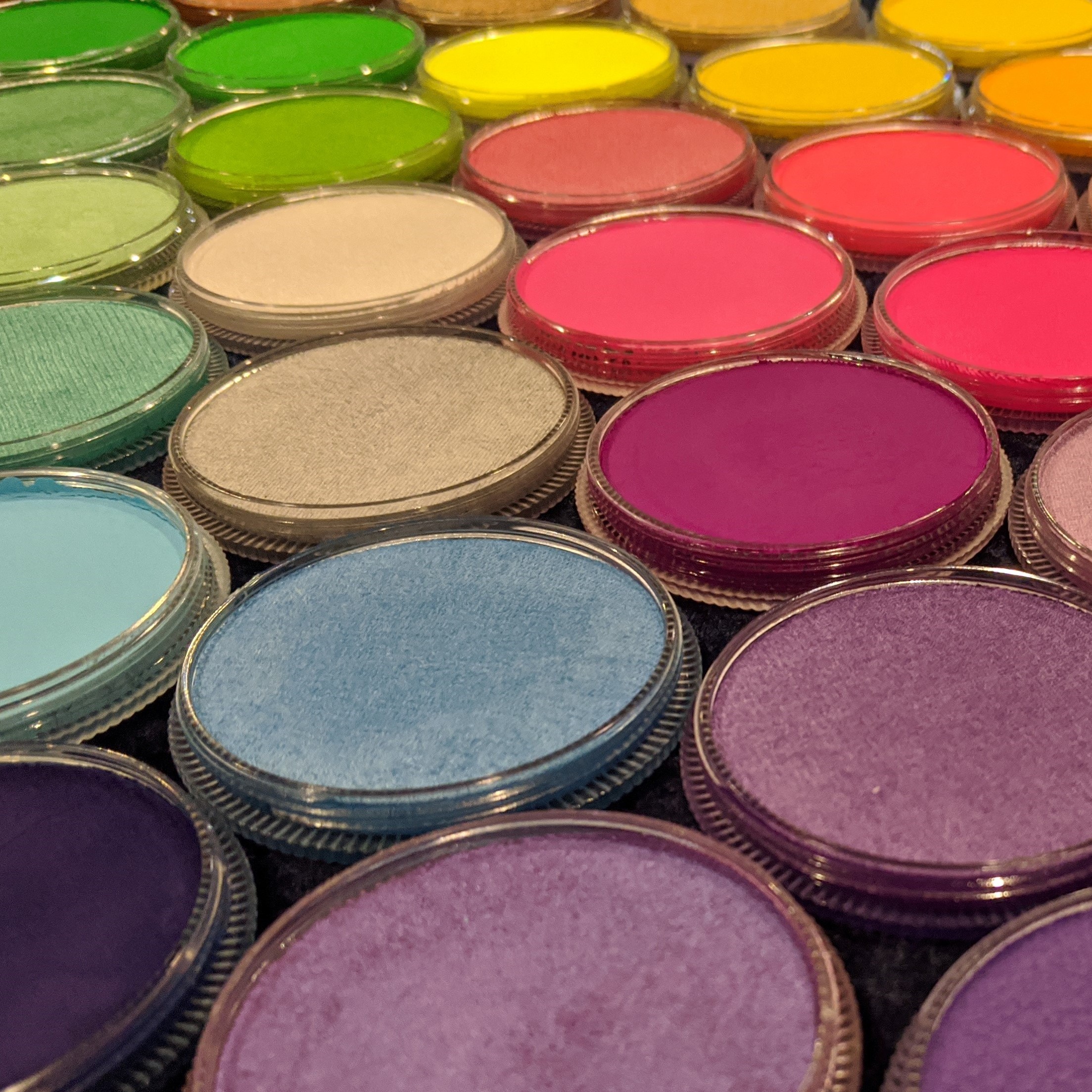Equipment
Skin-safe products
Any products used on the skin should be specifically designed for use on human skin. “Non-toxic” on the labels does not necessarily mean that it is safe to put on the skin. Use only professional quality face paints, cosmetic glitters and cosmetic adhesives. Face paints and glitters found in craft stores are often not cosmetic grade and may not be safe. Craft glitters can damage eyes. Self-adhesive gems are not made for use on skin.
Labels on some colours of some brands say to not use that colour near eyes or on lips. Please heed these warnings.
Neon colours
Neon (UV reactive) face and body paint has long been sold in Australia and widely used around the world by face painters. As of yet, the US FDA and EU Commission have not tested neon pigments to be used in cosmetics, therefore they have not been approved by the FDA or EU to be labelled as a cosmetic in the US and EU. Therefore, following FDA guidelines (in order to sell neon face paints in USA and Europe) labels of UV/Neon products may say something like, “For Hair and Special FX” or “A special effect product. Not a cosmetic item” or “Not intended to be used on skin” or “Prosthetic Paint”.
Cleaning your applicators
Ensure the kit is clean before you begin. Brand new brushes should be gently washed before first use. Between face painting sessions, face paint should be stored dry and away from heat. (see “Caring for Your Products” for more information).
It is recommended to use a fresh, clean sponge for each person. Sponges should be washed with soap and cool or luke-warm water. Hot water can set the paint into the sponge. After removing all the paint you can immerse face painting sponges in boiling water to sterilize them. But don’t do this with spounces that are glued to a handle as the hot water can dissolve the glue.
After washing your face painting sponges need to be fully dry before storing away so they don’t grow mold. Drying on the line in the sunshine is good for them. You can put them inside a mesh bag (an open-weave delicates bag) and peg that on the line.
Hygiene and Safety in Application
Personal hygiene
Obviously before you start face painting you should have clean hands. Use wet wipes and hand sanitiser as required. Do not do face painting if you are unwell or contagious.
Allergy
Do not paint anyone with skin allergies. If the client or child has sensitive skin, food allergies or reactions to soaps, creams, dyes, you should do a small patch test (or not paint them). To do a patch test, paint a small area (about the size of a 10 cent piece) on the inside of the elbow and wait 20 minutes, then check for any reaction, including redness or itching.
Some individuals may have an allergic reaction to even the most pure and non-toxic colours. If the client shows any type of allergic reaction during the painting procedure (e.g. paleness, shortness of breath, difficulty in breathing, undue swelling, puffiness around the eyes) the painting session should be discontinued and emergency medical attention should be obtained.
Infants and toddlers
There are no official evidence-based guidelines that I know of except that ASCIA (Australasian Society of Clinical Immunology and Allergy) states that the facial skin in babies is very sensitive and easily irritated. It makes sense to me therefore to be very cautious about painting infants and toddlers whose immune systems are still developing. Personally, I won’t paint anyone under the age of 2 yrs. At that age the child very rarely wants it; it’s only the parents that want it.
Please do not paint any child who doesn’t want to be painted. This sounds obvious, but parents often want it done more than the child and will sometimes hold down a crying child and tell you to “just do it”. It can be hard sometimes (if you’re not a very assertive person) to repeatedly refuse the parent’s request (or demand), especially if they are the one who hire you. They seem to think that once it’s done the child will be happy, but it’s only going to turn the child off face painting even more.
If the child is simply very shy I will suggest that they sit on mum or dad’s lap while I paint a rainbow on mum or dad’s hand. Often after they see this they are happy to have a little rainbow on their own hand. After that they often offer their other hand for more. 1 inch rainbows on a hand are perfect as it takes a mere second to paint something that they can recognise and is pretty and colourful. Painting their hand rather than their face is much less intimidating for the child and much more rewarding because they can see it without needing a mirror.
Safe application
Only paint clean, healthy, unbroken skin. Don’t paint over: cuts, scabs, cold sores, a rash, flaky skin, eczema, or acne. Do not paint anyone with conjunctivitis, lice, cold or flu, chicken pox or any other sign of infection. In some cases, if their face is unsuitable to paint, you may be able to paint their hand or arm instead.
Don’t apply paint or glitter very close to the eyes, especially on young children. The risks of painting close to the eyes include:
- irritating the extra sensitive skin around the eye;
- poking the eye when the child suddenly moves;
- the child rubbing the paint or glitter into their eyes later on;
- paint or soap going into the eye when the mother is washing the paint off;
When applying loose cosmetic glitter to the painted face with a puffer bottle, tell the model/client to close their eyes and why. Use your free hand to shield the eyes, especially with little kids who often open their eyes as soon as they feel the puff of glitter on their cheek.
If you do paint someone’s lips, it is best to use a ‘disposable’ lip swab, using a clean one for each person. I say ‘disposable’ because you may be able to wash and sterilize these between jobs in order to reuse them.
Washing brushes on the job
There are two schools of thought on washing brushes on the job between painting one person and the next.
- To wash and sterilize brushes after every use – between one person and the next – to minimize the risk of passing infection from one person to another. This may become more prevalent post-covid. There are various methods such as washing the brush thoroughly in warm water and soap, then soaking in 70% isopropyl alcohol for at least two minutes, then dried. (I make no claims as to the effectiveness of this method!)
- Others consider that sterilizing, even washing brushes between kids is an unnecessary difficulty in most circumstances and fairly pointless if that is the only hygiene measure taken. For example at a typical kids party where kids are freely mingling, touching each other, touching food that others will eat, coughing freely into the air, sterilizing your brushes is not going to stop colds, covid or chicken pox spreading. It is perhaps more important to avoid painting broken skin or other skin issues as mention elsewhere on this page.
Which approach you take is up to you and should be appropriate for the situation. Painting sick kids in hospital should have a very different approach to hygiene than painting siblings at home.
A few things to consider:
- Rinsing your brush in plain water may make it look clean but does nothing to reduce spread of germs.
- If you reload your brush while painting a face (or arm etc) you have potentially put germs onto the surface of the cake of paint to be picked up by your sterilized brush when painting the next person. So if you intend to sterilize between people you must consider how to solve this issue.
- If you use isopropyl alcohol or other sanitizer you need to be sure it’s well rinsed out or that it won’t create a reaction with the face paint. Do your research.
Positioning and Set-up
Seating arrangments
Face painting can be torture on your back with the wrong chairs or positioning for long periods. When a child sits down to have their face painted, they always lean or slump back in the chair, and often look down. You will find yourself leaning forward and literally bending your back to paint their face. It may not trouble you at first, but when you stop after an hour or two, your back will ache.
The key things to avoid this are:
- Aim to have their face at, or a little below your eye level. (Higher can give you aching shoulders instead.)
- Bring their face close to you, so you don’t have to lean towards them.
- Keep your back straight, and if you have to lean forwards, tilt at the hips instead of bending your back. You have to consciously and repeatedly remind yourself of this.
- Keep their face looking at your face, not down at their lap.
- Avoid a lot of twisting and turning, but don’t stay in the same position for long periods either. Get up and move regularly.
Ok, so this is much easier said than done! So here are some tips to help you achieve this. There are different set-ups which suit different face painters and different situations, so you’ll need to experiment a little to see what is most comfortable for you.
With kids:
Both sitting:
- Ideally the chair for the kids is a little taller than your own or has some kind of booster cushion for little kids to sit on to raise them to your height.
- It’s also ideal to have a cushion or similar on the back of the chair to keep them forward, not slumped back where you have to lean forward to reach them.
- Don’t use those folding camp chairs that has a seat that dips in like a bowl. The shape of the seat is not made for sitting up straight.
- I have the kids place their hands on their knees – this brings their body forward. I also ask them to sit up straight and usually have to keep reminding them of this.
- With very small kids it’s ideal to have them sit on mum or dad’s lap. Mum or dad acts as a booster seat as well as making them less nervous about the stranger (you).
They sit and you stand:
- For kids you’ll need something about bar stool height. There are tall director’s chairs that may be suitable.
- Standing can make it easier to and to move around the client and access everything on your table.
- It can be tiring to be on your feet to stand for long periods. A rubber or foam mat under to stand on may help.
- You may still have to lean forward if the height of chair is not suitable for your height and child’s height. As the child’s heights will vary, no chair will always be ideal. It will usually still help to have a cushion at the back to keep them sitting upright.
- Small kids will have problems getting in and out of the tall chair on their own. Ideally their parents would lift them up and down but in reality, it will mostly be up to you to lift or at least help them. You can provide a step stool for them to use to climb up and down but make sure it isn’t one that tips if you stand on the edge.
You sit, they stand:
- I find this particularly ideal when its’ a party and they are all of a certain age. Not only are they about my height when I’m sitting, it brings their face closer.
- You can have them stand in front of, or even, between your knees. Getting them to put their hands on your knees keeps them close. This won’t work for you if you don’t like people in your personal space.
- It is also much quicker to get them in position than having them get in and out of a chair, so it’s good for rush jobs where every second counts.
With teens and adults:
What works for you will depend on their height comparative to yours. Both sitting can work but their face will be further back because of their longer legs. On the other hand they are more compliant with leaning forward to help you.
For tall teens and adults I usually stand while they sit. I suppose it’s partly because I’m shorter than average so both sitting means me reaching up to their face. I also feel that standing beside their chair feels a little less “in their face”.
Turning
To paint on the side of their face, ask them to turn their head and/or use your non-painting hand to guide them, rather than twisting your body around to reach. It helps a lot to have something you can ask them to look at – e.g. a poster on the wall, rather than just “turn your head” or “look left”. It’s easier for the little ones to understand and gives them something to focus on, so they’ll keep their head in that position for longer. For wriggly, little kids, ask their mum to stand where you want the child to look.
Set-up
The kids that are waiting and watching will get in the way and into your stuff if don’t manage them. There’s often a kid or two who’ll try to stick their finger into your cake of face paint. Undirected, they’ll crowd around the table and chairs, leaning on them and bumping you and the person you are painting.
When possible, set up your table in a corner to limit the kids’ access to your table and equipment. I have a large plastic sign on one side of my table which has advertising and info for parents, but most importantly forms a barrier to stop kids getting to my paint. If there’s going to be a queue, get them to queue on your other side – away from your table and chairs. A few chairs for the start of the queue is ideal.
Reminder
Remember to look after your own needs, especially if you’re painting for more than two hours: take drinking water. Take breaks to stretch, change position, eat and go to the toilet. If you’re like me and many face painters, while painting you’ll get into the ‘zone’ and not notice hunger, thirst or pain until you stop, and then it will hit you like a brick!

























































 Regular, Pearl and Neon Face & Body Paint
Regular, Pearl and Neon Face & Body Paint StarBlend™ Pressed Powder Cake Makeup
StarBlend™ Pressed Powder Cake Makeup Other Face Paint and Makeup
Other Face Paint and Makeup Filbert Brushes
Filbert Brushes Small Containers
Small Containers